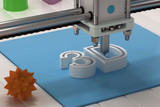Can 3D printing be used for mass production?
Factories, as drivers of innovation in the industrial revolution, are cathedrals of productivity, built to house specialized processes and motivate the division of labor. However, the benefits of the factories suggest its limitations, they are not reprogrammable, to reorganize a new product it would be necessary to reorganize its machinery. All this is about to change. In another industrial revolution, men will create new things in different ways by adopting impossible forms thanks to the use of 3D printers.
Origins of 3D printing
The beginnings of the 3D printing revolution were not very successful since customers did not want the products printed by the machine and the producers wanted items that were outside their capabilities to be printed. The first printers cost thousands of dollars and were able to produce rough, unfinished and cheap plastic prototypes. On the other hand, GE invested millions of dollars in a printer to create a limited number of metal-based components, but the process was slow, expensive and dangerous. At present, most of the manufactured products have a metallic component. Desktop Metal wants to take over this large segment of the metal manufacturing market, whose value is estimated in trillions of dollars. The founder of Desktop Metal ensures that the market is expanding,
3D metal printers
The future of production lies in the 3D metal printers that are currently created by the American start-up Desktop Metal, which was founded in 2016 by MIT professors and has obtained financing from General Electric (GE), BMW and Ford.
3D metal printing is complex. This is because it is difficult to get the printer to expel molten metal in the same way as it does with the polymer since the machines should work at very high temperatures to keep the molten metal. MIT researchers have designed a new technology called binder flow printing in which the powdered metal is mixed with a polymer. The polymer hardens and then an oven burns and removes the polymer, melting the metal in a phase called sintering. The company will market two types of 3D printers:
Studio, for the creation of metallic prototypes. This machine will extract the powdered metal mixed with the polymer to create 3D objects.
Industrial production system, which will be the first 3D metal printer that can print mass The machine sprinkles metallic powder in a pattern indicated by a digital folder and deposits the binder in a single pass, creating a 50-micrometer thick layer. The process is a hundred times faster and 80% cheaper than prototypes of previous 3D printers. Desktop Metal could make 546 hydraulic valves in one day.
Desktop Metal hopes to be able to launch its printers by the end of 2019. However, it will first test its 3D printers in pioneer manufacturers such as Ford, which are investigating whether 3D printing is truly cheaper, faster and more flexible than traditional manufacturing methods. Companies like Google have already acquired Studio printers to design and prototype the devices they plan to sell in the coming years.
Recent Posts
-
Best Computer Screens for Home and Office
Computer display screens, often referred to simply as monitors, have undergone a remarkable evolutio …27th Dec 2023 -
Unleashing Creativity Down Under: The Best 3D Printing Filament Options in Australia
Australia has become a hub for creativity and innovation, and 3D printing is no exception. With an …3rd Jun 2023 -
How is 3D Printing Technology enhancing the Advertising Industry?
3D printing, or additive manufacturing, is the process of using digital files to create three- dime …8th May 2023

 FREE SHIPPING ON ORDER OVER $75
FREE SHIPPING ON ORDER OVER $75
 LOYALTY PROGRAM
LOYALTY PROGRAM
 SHIPPING WORLDWIDE
SHIPPING WORLDWIDE



